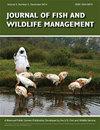利用垂钓者的努力为渔业管理提供信息:使用收获和收获率来估计白鲟的丰度
IF 0.9
4区 环境科学与生态学
Q4 BIODIVERSITY CONSERVATION
引用次数: 0
摘要
摘要在某些系统中,由于复杂的种群结构和采样努力的限制,传统的鱼群丰度估算方法是不可行的。林肯估算器提供了一种使用收获和收获率来估算丰度的技术。使用垂钓者捕获数据可以解决估算器的假设问题,而无需依赖可能需要大量现场作业或成本高昂的方法。在萨克拉门托-圣华金河流域,使用标记-再捕获方法获得了白鲟鱼跨蒙塔努斯丰度的历史估计。然而,白鲟种群特征经常导致模型假设的违反,如种群关闭和独立捕获概率。我们使用联合似然开发了林肯估计器的一个版本,使用该方法和经验数据估计了2015年萨克拉门托-圣华金河流域白鲟的丰度,并在模拟研究中评估了估计的准确性和精度。用我们的模型框架表示的收获和收获率来估计丰度,有可能是精确和准确的。使用贝叶斯方法拟合的基于联合似然的方法是有利的,因为所有的变异源都包含在一个模型中。当该模型应用于萨克拉门托-圣华金河流域的白鲟和模拟数据集中的类似条件时,丰度估计的精度很低。通过模拟,精度和准确性随着高奖励和标准标签数量的增加,标签报告率,标签保留率和收获率的增加而增加。结果显示了使用这种方法时潜在的误差来源,并表明增加标记鱼的数量和标签报告率是提高模型丰度估计精度和准确性的潜在措施。本文章由计算机程序翻译,如有差异,请以英文原文为准。
Leveraging Angler Effort to Inform Fisheries Management: Using Harvest and Harvest Rate to Estimate Abundance of White Sturgeon
Abstract Traditional methods for estimating abundance of fish populations are not feasible in some systems due to complex population structure and constraints on sampling effort. Lincoln’s estimator provides a technique that uses harvest and harvest rate to estimate abundance. Using angler catch data allows assumptions of the estimator to be addressed without relying on methods that could be prohibitively field-intensive or costly. Historic estimates of White Sturgeon Acipenser transmontanus abundance in the Sacramento-San Joaquin River basin have been obtained using mark-recapture methods. However, White Sturgeon population characteristics often cause violations of model assumptions, such as population closure and independent capture probabilities. We developed a version of Lincoln’s estimator using a joint likelihood, estimated abundance of White Sturgeon in the Sacramento-San Joaquin River basin in 2015 using this method and empirical data, and assessed accuracy and precision of estimates in a simulation study. Estimating abundance using harvest and harvest rate, as represented by our model framework, has the potential to be precise and accurate. The joint likelihood-based approach fitted using Bayesian methods is advantageous because all sources of variation are included in a single model. Precision of abundance estimates was low when the model was applied to White Sturgeon in the Sacramento-San Joaquin River basin and to similar conditions in a simulated dataset. Using simulation, precision and accuracy increased with increases in the number of high-reward and standard tags released, tag reporting rate, tag retention rate, and harvest rate. Results demonstrate potential sources of error when using this approach and suggest that increasing the number of tagged fish and tag reporting rate are potential actions to improve precision and accuracy of abundance estimates of the model.
求助全文
通过发布文献求助,成功后即可免费获取论文全文。
去求助
来源期刊

Journal of Fish and Wildlife Management
BIODIVERSITY CONSERVATION-ECOLOGY
CiteScore
1.60
自引率
0.00%
发文量
43
审稿时长
>12 weeks
期刊介绍:
Journal of Fish and Wildlife Management encourages submission of original, high quality, English-language scientific papers on the practical application and integration of science to conservation and management of native North American fish, wildlife, plants and their habitats in the following categories: Articles, Notes, Surveys and Issues and Perspectives. Papers that do not relate directly to native North American fish, wildlife plants or their habitats may be considered if they highlight species that are closely related to, or conservation issues that are germane to, those in North America.
 求助内容:
求助内容: 应助结果提醒方式:
应助结果提醒方式:


